*This article originally appeared on Marketing Insider Group.
As a B2B marketer you’re constantly under fire. Between your executive team debating your budget to the sales team demanding BETTER leads and MORE opportunities, it’s like the hunger games out there. Now more than ever, demand generation and content marketers are worried about failing to meet lead-based goals. Lucky for you, I have three new research-based insights to help improve your strategy and ensure that you don’t underdeliver on your lead generation goals to drive pipeline development. After implementing these changes, everyone at your company will be singing your praises versus slashing your budget.
NEW B2B CONTENT MARKETING AND LEAD GENERATION RESEARCH
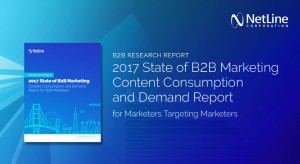 My team at NetLine just wrapped up a new research study that examines more than 7 million long-form content downloads taking place across the NetLine B2B content syndication network in the past 12 months. The research analyzes B2B marketers actively consuming content in comparison to the most targeted B2B marketing personas—campaigns run by marketers targeting marketers. Three powerful insights surfaced in the research that marketers seem to be getting wrong.
My team at NetLine just wrapped up a new research study that examines more than 7 million long-form content downloads taking place across the NetLine B2B content syndication network in the past 12 months. The research analyzes B2B marketers actively consuming content in comparison to the most targeted B2B marketing personas—campaigns run by marketers targeting marketers. Three powerful insights surfaced in the research that marketers seem to be getting wrong.
HOW TO AVOID LEAD GENERATION FAILURE:
#1 NEVER GO ONE-SIZE-FITS-ALL WITH YOUR CONTENT
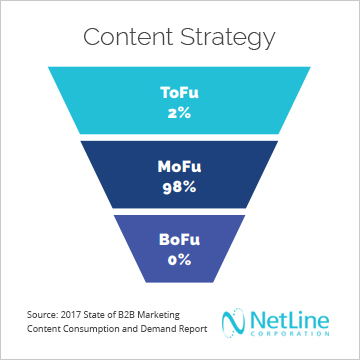 In review of all B2B content syndication lead generation campaigns run in the past 12 months, the overwhelming majority of campaigns used Middle of Funnel (MoFu) content to reach the target audience, marketers. Diving directly into one level of content that speaks to an organization’s values and benefits is risky. You must consider the professionals in the marketplace that haven’t decided to make a change, let alone interested in evaluating your solution.
In review of all B2B content syndication lead generation campaigns run in the past 12 months, the overwhelming majority of campaigns used Middle of Funnel (MoFu) content to reach the target audience, marketers. Diving directly into one level of content that speaks to an organization’s values and benefits is risky. You must consider the professionals in the marketplace that haven’t decided to make a change, let alone interested in evaluating your solution.
Robert Rose of The Content Advisory weighed in on his perspective of the research findings:
One of the most powerful insights from the report is how the need for a balanced content strategy at every stage of the buyer’s journey is so important. It’s simply not good enough to have a homogenous content creation and distribution strategy for all aspects of the buyer’s journey. Each and every stage of that journey now has unique content consumption behaviors and personas involved.
These are great points made by Robert. The truth is that the majority of professionals researching and reading your long-form content will likely be net-new to your organization and could be at any stage in the buyer’s journey. To solve for this, take a balanced approach with the content you provide. For example: do not solely produce features and benefits guides for your solutions no matter how well you think you can tell ‘the story.’
Taking this a step further, when you do diversify your content mix, you will need to rearchitect your targeting and lead follow-up strategy. Which brings me to my next point…
#2 STOP NEGLECTING INFLUENCERS OF THE BUYING COMMITTEE
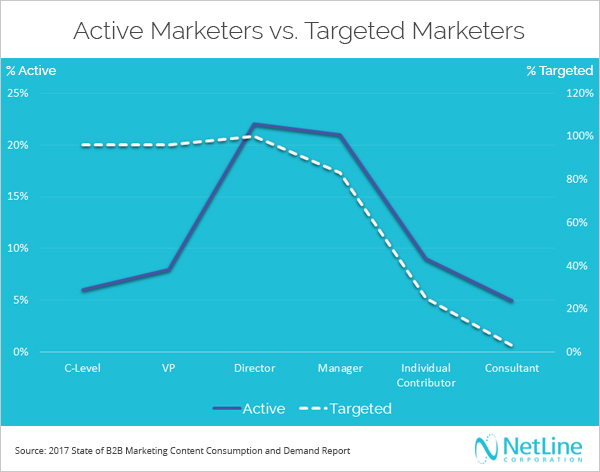 In the past year, 65% of campaigns targeting marketers excluded 17% of the active marketing audience by applying job level filters that rejected any leads generated by Senior Employees, Individual Contributors, and Consultants. Instead, the majority of campaigns (85%) were all targeting the same coveted segment of C-suite professionals (CEOs and VPs) who in reality only make up 14% of active marketing audience consuming long-form content. As you can see by this chart, there is a significant gap in supply and demand of the C-suite, along with untapped opportunities outside the C-suite. Yes, the C-suite can remain within your target audience; however, organizations need to come to grips with reality:
In the past year, 65% of campaigns targeting marketers excluded 17% of the active marketing audience by applying job level filters that rejected any leads generated by Senior Employees, Individual Contributors, and Consultants. Instead, the majority of campaigns (85%) were all targeting the same coveted segment of C-suite professionals (CEOs and VPs) who in reality only make up 14% of active marketing audience consuming long-form content. As you can see by this chart, there is a significant gap in supply and demand of the C-suite, along with untapped opportunities outside the C-suite. Yes, the C-suite can remain within your target audience; however, organizations need to come to grips with reality:
- The C-suite is an extremely narrow segment of professionals.
- The C-suite consumes less long-form content than other professionals.
- There is a larger population of non C-suite marketers researching business needs and downloading long-form content.
Lightbulb! Marketers have a huge opportunity to expand their targets to the diverse profile of professionals within the marketing buying committee and/or directly influencers to the buying committee. This includes Managers, Senior Employees, and Individual Contributors—as well as Consultants.
Think about it this way, if you continue to solely focus on the C-suite you will reach fewer professionals within organizations, and minimize your exposure and credibility. Any competitor that reaches incremental professionals within an organization outside the C-suite is much more likely to convert new accounts than you are. #Ouch
Robert Rose concurred with this sentiment,
“Your strategy must account for the varying levels of influencers within the buying committee who are now more commonly outside the C-suite.”
#3 DON’T SMOTHER CONTENT-SOURCED LEADS
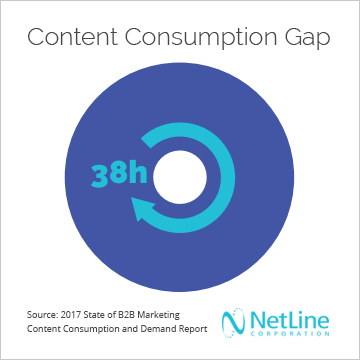 Our research has shown that marketing professionals who submit a form to download long-form content do not actually open the content to read it for more than 36 hours on average. Even more eye opening, C-level marketing professionals averaged more than 48 hours. So what does this say about lead follow-up? A LOT!
Our research has shown that marketing professionals who submit a form to download long-form content do not actually open the content to read it for more than 36 hours on average. Even more eye opening, C-level marketing professionals averaged more than 48 hours. So what does this say about lead follow-up? A LOT!
Leads generated by long-form content need to be handled differently than other leads. For example: NetLine recommends that when a prospect requests your white paper, sales should wait 48 hours to reach out to discuss the content. But when a prospect requests a demo, sales should contact them immediately to schedule. That’s make sense, right?
HOW TO IMPROVE:
So, when you think about your lead follow-up on long-form content such as white papers, eBooks, and guides (5+ page documents) professionals need time to consume this content. If your marketing or sales team begins their approach immediately after the lead is generated you’re going to have a problem, here’s why:
The professional will likely not be ready to have a conversation with you about the content – because they haven’t read it.
- The professional will likely be alarmed by your eager questioning.
- The professional will likely be labeled bad/not qualified by your sales team
- Your campaign will likely be labeled as a failure.
The good news is there is a very simple way to avoid this mistake. Share the stats with your team, and then recommend this solution:
Leads generated by long-form content need time to digest your content. Suggest that your sales team wait 48 hours before contacting to ensure that the prospect is well informed enough to have an educated discussion. This will save your sales team time and reduce poor lead dispositioning…and more importantly not scare away prospects with immediate contact. In the meantime, your sales team could utilize a light touch email, such as:
“Thanks for checking out our white paper. I’ll check in with you in a few days to see what you thought. In the meantime, please don’t hesitate to reach out with questions regarding XYZ.”
TAKEAWAYS FOR B2B MARKETERS
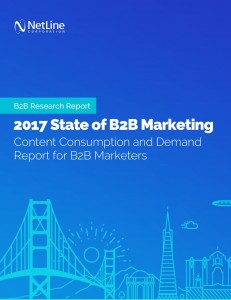 It has become incredibly important for B2B marketers to understand the stages of the buyer’s journey, the personas involved, and how to nurture them to conversion. I encourage you to take the insights and recommendations outlined above back to your team and discuss how this should impact your tactical plans. If you continue to make the above mistakes you will likely lose to your competition and lose your marketing budget. The good news is that the recommendations here have minimal to zero costs associated in making the improvements.
It has become incredibly important for B2B marketers to understand the stages of the buyer’s journey, the personas involved, and how to nurture them to conversion. I encourage you to take the insights and recommendations outlined above back to your team and discuss how this should impact your tactical plans. If you continue to make the above mistakes you will likely lose to your competition and lose your marketing budget. The good news is that the recommendations here have minimal to zero costs associated in making the improvements.
Grab your free copy of the research study 2017 State of B2B Marketing Content Consumption and Demand Report from NetLine Corporation to learn more.
